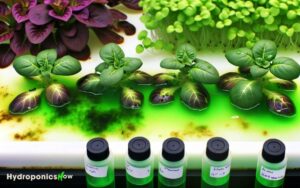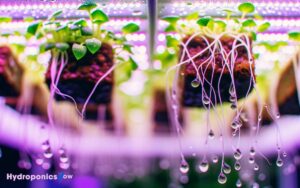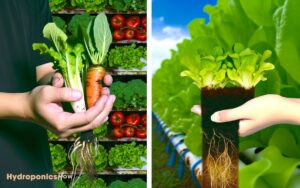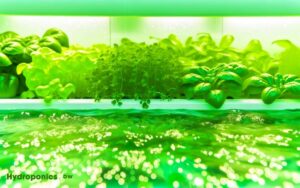How Are There Many Hydroponic Plants in Pennsylvania?
Pennsylvania’s hydroponic farming sector is experiencing significant growth, fueled by modern technology and rising consumer interest in pesticide-free produce.
While it’s hard to pinpoint an exact number of hydroponic farms, there’s clear evidence of increased investments and farm expansions.
Utilizing methods like nutrient film technique and deep water culture, farmers achieve up to 50% higher yields and 90% water savings. Key crops include tomatoes, lettuce, and herbs.
The state’s strategic location and infrastructure enhance this sector’s expansion and sustainability. To gain deeper insights into this burgeoning field, understanding current trends and future prospects is essential.
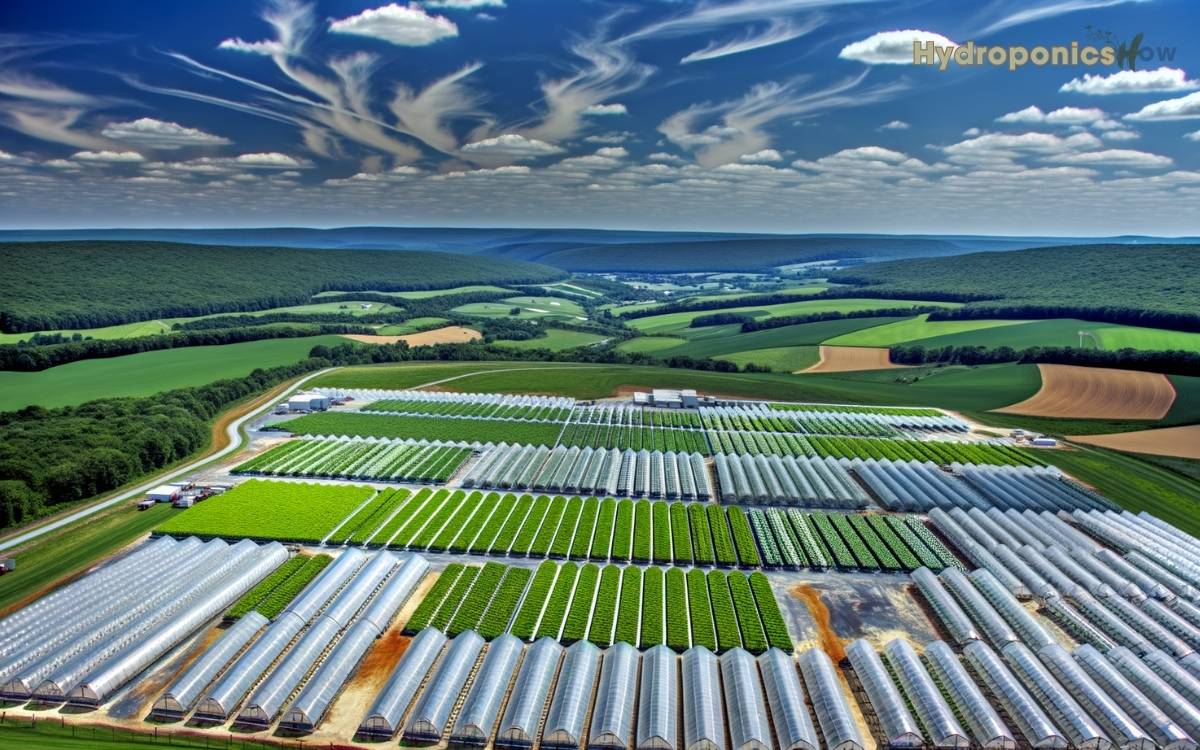
Key Takeaways
Overview of Hydroponics
Hydroponics, a method of growing plants without soil, has been shown to increase yields by up to 50% compared to traditional agriculture.
You’ll find that hydroponic systems use nutrient-rich water solutions to nourish plants, which can result in faster growth rates and higher productivity.
This method is particularly efficient in areas with poor soil quality or limited space, as it allows for vertical farming and controlled environments.
Data indicates that hydroponic systems also use up to 90% less water than soil-based farming, making them more sustainable.
By eliminating soil-borne diseases and pests, hydroponics can reduce the need for pesticides.
These factors combine to make hydroponics a viable alternative to conventional farming, especially in urban settings.
Growth of Hydroponic Farming
In recent years, Pennsylvania has seen a significant increase in hydroponic farming operations. This growth is driven by advancements in technology and a growing demand for sustainable agriculture.
You can observe this growth through several key indicators:
- Increased Investment: Financial backing for hydroponic farms has surged, with venture capital and public funds flowing into new and expanding operations.
- Expanding Facilities: Existing hydroponic farms are scaling up, with facilities expanding in size and capacity.
- Technological Integration: Modern technology, such as automated systems and LED lighting, is being adopted to enhance productivity and efficiency.
- Market Demand: Rising consumer interest in locally-sourced and pesticide-free produce is propelling market growth.
Analyzing these trends, it’s evident that hydroponic farming is becoming an essential component of Pennsylvania’s agricultural landscape.
Benefits of Hydroponics
Moreover, as Pennsylvania’s hydroponic farming sector expands, the numerous benefits of this innovative agricultural method become increasingly clear.
You can achieve up to a 90% reduction in water usage compared to traditional soil farming, according to the University of Arizona.
Yield rates are also impressive; hydroponic systems can produce crops up to 30% faster. Additionally, these systems require less space, allowing for vertical farming and urban agriculture.
By eliminating soil, you reduce the risk of pests and diseases, cutting down on pesticide use by nearly 70%. Moreover, hydroponics allows for year-round cultivation, ensuring consistent supply regardless of seasonal changes.
These advantages collectively enhance efficiency, sustainability, and profitability in the agricultural sector.
Hydroponic Techniques
Several hydroponic techniques, such as nutrient film technique (NFT), deep water culture (DWC), and aeroponics, offer unique advantages and efficiencies for growers in Pennsylvania. Each method caters to different plant needs and operational scales.
- NFT: Utilizes a thin film of nutrient solution, promoting efficient oxygen and nutrient uptake.
- DWC: Plants’ roots are fully submerged in nutrient-rich water, ensuring constant access to nutrients.
- Aeroponics: Roots are suspended in the air and misted with a nutrient solution, maximizing oxygen exposure.
- Wick system: Simple and passive, using wicks to draw nutrients to the roots.
Key Hydroponic Crops
Tomatoes, lettuce, and herbs are among the most popular hydroponic crops grown in Pennsylvania due to their high yield and market demand.
Tomatoes offer a significant return on investment because of their continuous fruiting cycle and high consumer demand.
Lettuce, particularly varieties like Bibb and Romaine, grows quickly and requires minimal space, making it a staple in hydroponic systems. Herbs such as basil, cilantro, and mint are favored for their rapid growth and high market value.
These crops contribute to a sustainable, year-round agricultural model, reducing the dependency on seasonal farming.
By focusing on these key crops, you can optimize your hydroponic operations and meet local market needs efficiently.
Pennsylvania’s Hydroponic Farms
How do Pennsylvania’s hydroponic farms leverage advanced technologies to maximize crop yields and sustainability?
They employ cutting-edge techniques to guarantee ideal growth conditions and resource efficiency.
Key technologies include:
- Automated nutrient delivery systems: Precisely control the mix and timing of nutrient release, enhancing plant health and growth rates.
- LED grow lights: Mimic natural sunlight, providing plants with the necessary light spectrum for photosynthesis while reducing energy consumption.
- Climate control systems: Maintain ideal temperature and humidity levels, ensuring consistent crop quality year-round.
- Data analytics: Monitor and analyze growth metrics in real-time, allowing for immediate adjustments to improve yield outcomes.
These methods not only boost productivity but also notably reduce the environmental footprint of farming operations.
Factors Driving Adoption
The adoption of hydroponic farming in Pennsylvania is driven by a combination of economic incentives, environmental concerns, and advancements in agricultural technology.
You’re seeing more farmers turn to hydroponics due to factors such as improved crop yields and reduced water usage.
| Factor | Impact |
|---|---|
| Economic Incentives | Increased profitability |
| Environmental Concerns | Reduced water and land usage |
| Technology Advances | Enhanced growth efficiency |
| Market Demand | Higher demand for local produce |
Economic incentives, like increased profitability, are essential. Environmental concerns push you towards sustainable practices, such as using 90% less water.
Technological advancements help enhance crop growth efficiency, making it feasible to meet rising market demands. These factors collectively make hydroponic farming an attractive option in Pennsylvania.
Economic Impact
Hydroponic farming has greatly bolstered Pennsylvania’s agricultural economy by increasing crop yields and reducing resource costs.
You can see the economic benefits in various ways:
- Increased Crop Yields: Hydroponic systems yield crops up to 30% faster compared to traditional soil farming.
- Resource Efficiency: Hydroponics uses up to 90% less water, markedly cutting down on water expenses.
- Year-Round Production: Controlled environments enable continuous crop cycles, ensuring steady revenue streams.
- Reduced Labor Costs: Automation and efficient systems reduce the need for manual labor.
These factors collectively enhance profitability and sustainability for Pennsylvania’s farmers. By adopting hydroponics, you’re not only investing in advanced technology but also ensuring long-term economic resilience in the agricultural sector.
Environmental Benefits
You’ll find that hydroponic systems use up to 90% less water compared to traditional soil-based agriculture.
This method also eliminates soil erosion, a significant environmental issue in conventional farming.
Reduced Water Usage
Frequently, hydroponic systems in Pennsylvania demonstrate a significant reduction in water usage compared to traditional soil-based agriculture.
This efficiency stems from their ability to recycle and reuse water, which minimizes waste. By adopting hydroponics, you can expect to use up to 90% less water.
Consider these key points:
- Water Recycling: Hydroponic systems recirculate water, reducing the need for constant replenishment.
- Targeted Delivery: Water is delivered directly to plant roots, decreasing evaporation and runoff.
- Controlled Environment: Indoor setups prevent water loss due to weather conditions.
- Efficient Absorption: Plants absorb water more efficiently, further lowering overall consumption.
This data underscores hydroponics as a viable solution for conserving water resources in agriculture.
Decreased Soil Erosion
By eliminating the need for soil, hydroponic systems in Pennsylvania greatly reduce soil erosion, thereby offering substantial environmental benefits. Traditional farming often leads to soil degradation through practices like tilling and overuse of chemical fertilizers.
Hydroponics bypasses these issues entirely by growing plants in nutrient-rich water solutions.
| Metric | Traditional Farming | Hydroponic Farming |
|---|---|---|
| Soil Erosion | High | None |
| Chemical Runoff | Significant | Minimal |
| Land Requirement | Extensive | Compact |
| Crop Yield per Acre | Variable | Consistent |
This data shows the clear advantages of hydroponics over traditional farming. You’ll find that hydroponics not only conserves resources but also promotes a healthier environment by preventing soil erosion and reducing chemical runoff.
Challenges Faced
Hydroponic farmers in Pennsylvania encounter numerous challenges. One major obstacle is the high initial setup costs involved.
To start a hydroponic system, farmers need to invest substantially in equipment such as grow lights, nutrient delivery systems, and climate controls. These components ensure that plants receive the necessary light, nutrients, and environmental conditions for optimal growth. Farmers researching where to buy hydroponic plants can find suppliers that offer a variety of seedlings suited for soilless cultivation. By selecting high-quality equipment and healthy plants, growers can maximize their yield and efficiency in a controlled indoor environment.
The costs of this equipment can quickly add up, making entry barriers high for many individuals interested in hydroponic farming.
Another significant challenge faced by hydroponic farmers is the need for specialized knowledge. Operating a successful hydroponic system requires expertise in areas such as plant biology, nutrient solutions, and system maintenance.
The learning curve can be steep, and farmers must be dedicated to acquiring the necessary skills to ensure the success of their venture.
In addition to the financial and knowledge-related challenges, hydroponic farmers in Pennsylvania must also contend with issues such as high energy consumption.
Hydroponic systems often rely on artificial lighting to provide plants with the necessary light for growth. As a result, farmers may experience increased energy costs when operating their systems.
Furthermore, water management is a crucial aspect of hydroponic farming. While these systems are generally more water-efficient than traditional soil-based methods, they require vigilant monitoring to prevent issues such as root rot.
Farmers must carefully manage the water and nutrient levels in their systems to ensure the health and productivity of their crops.
Future Prospects
As technological advancements and market demand continue to grow, the future prospects for hydroponic farming in Pennsylvania look increasingly promising. You’ll find that new innovations in LED lighting and nutrient delivery systems are reducing operational costs.
According to recent market analysis, the hydroponic industry in the U.S. is projected to grow at a compound annual growth rate (CAGR) of 11.3% through 2027. Pennsylvania’s strategic location and robust agricultural infrastructure position it well to benefit from this growth.
Additionally, increasing consumer preference for locally sourced, pesticide-free produce is driving demand. By adopting hydroponic systems, you can capitalize on these trends, ensuring higher yields and consistent quality, while also contributing to sustainable farming practices.
Conclusion
You’re standing at the cusp of a green revolution. Hydroponic farming in Pennsylvania is blossoming, offering a sustainable and economically viable future.
By adopting hydroponics, you’re not just conserving resources but also cultivating a healthier planet.
Data shows significant growth in hydroponic plants, signaling promising opportunities ahead. Despite challenges, the potential for innovation and efficiency is vast.
Embrace this burgeoning trend, and you’ll see that the sky’s the limit for hydroponic agriculture in Pennsylvania.

